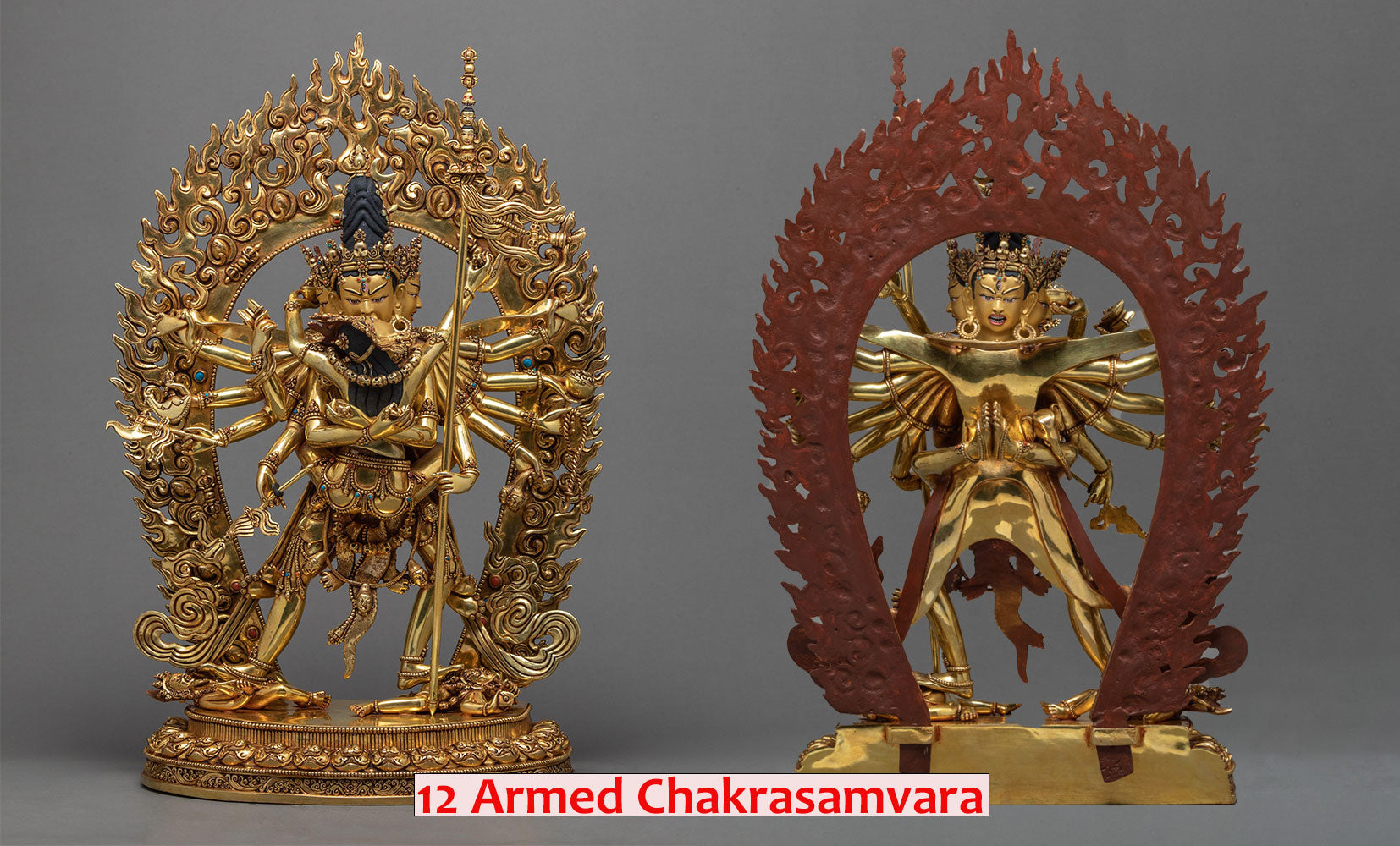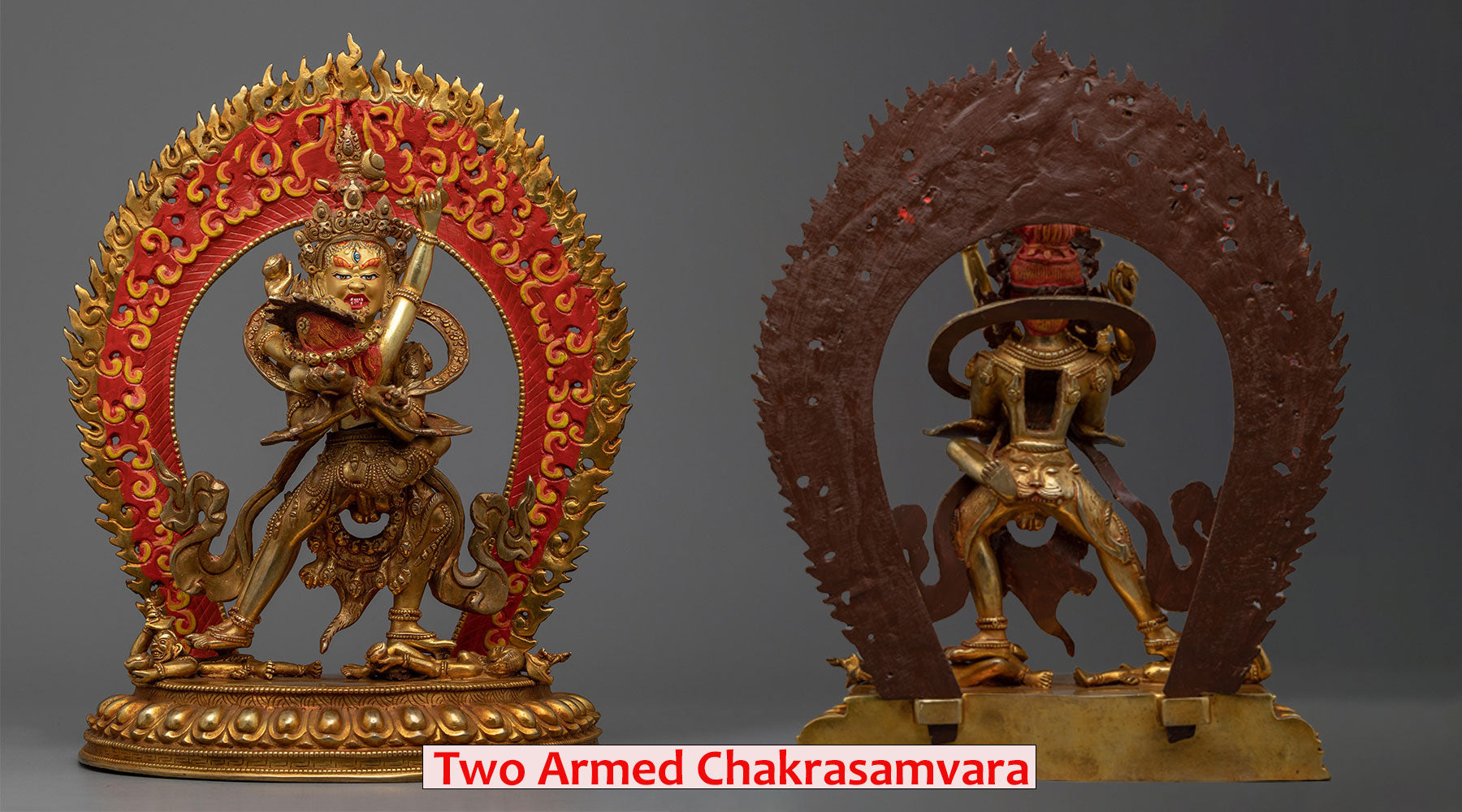Chakrasamvara Deity: Exploring the Divine Feminine in Tantra
Chakrasamvara, known as the "Wheel of Bliss," is central to Hindu and Tibetan Buddhist traditions. This multifaceted deity, portrayed in diverse manifestations, embodies the profound tenets of Tantra, offering a transformative path toward spiritual awakening and enlightenment. In this piece, we delve into the origins, symbolism, significance, and practice of Chakrasamvara, unveiling its potent influence on spiritual growth and realization.
Key Takeaways
- Chakrasamvara is a significant deity in Hinduism and Tibetan Buddhism.
- It symbolizes the essence of Tantra and the path to spiritual enlightenment.
The Origin and History of Chakrasamvara
Chakrasamvara has a rich and ancient history spanning Hindu and Tibetan Buddhist traditions. Its roots can be traced back to ancient India, where it emerged as a deity associated with Tantra.
The Evolution in Hinduism
In Hinduism, Chakrasamvara is often regarded as a manifestation of Lord Shiva and Parvati, with their worship deeply intertwined in ancient scriptures such as the Tantrasara and Chakrasamvara Tantra. These texts provide intricate guidance on rituals, meditation techniques, and mantras associated with Chakrasamvara, highlighting the significance of spiritual union.
Integration into Tibetan Buddhism
The journey of Chakrasamvara from Hinduism to Tibetan Buddhism witnessed adaptation and evolution. Chakrasamvara assumed a distinct form within Tibetan Buddhism, amalgamating indigenous Tibetan beliefs with Indian Tantric traditions. This divine entity became a central figure in the Kagyu and Gelugpa schools, among others, exemplifying a remarkable synthesis of spiritual practices.
Chakrasamvara's Iconography
Chakrasamvara is typically depicted with multiple heads and arms, symbolizing the deity's capacity to transcend duality and embrace the unity of all facets of existence. Each head signifies a unique aspect of wisdom, while the numerous arms denote the deity's ability to engage in multiple activities simultaneously.
- Yab-Yum: The Union of Masculine and Feminine
One of the most iconic representations of Chakrasamvara is the yab-yum (father-mother) posture, where the deity is portrayed in a loving embrace with his consort, Vajravarahi. This union signifies the harmonious equilibrium between masculine and feminine energies, a fundamental theme in Tantra.
- The Significance of Chakrasamvara in Tantra
Chakrasamvara embodies the fundamental tenets of Tantra, a spiritual discipline aimed at transcending conventional dualities and embracing the divine in all aspects of life. Here's why Chakrasamvara holds profound importance in the realm of Tantra:
- Embracing the Physical and Spiritual
Tantra strongly emphasizes the holistic nature of existence, encouraging individuals to embrace both the physical and spiritual dimensions of life. Chakrasamvara's distinctive iconography, featuring multiple arms and heads, symbolizes amalgamating diverse experiences and energies into one's spiritual voyage.
- The Path of Transcendence
The intricate rituals and meditation practices associated with Chakrasamvara are meticulously crafted to guide practitioners beyond ordinary consciousness. This deity acts as a mentor on the journey of transcendence, assisting individuals in transcending their ego and expanding their limited perceptions.
- Sacred Union
In the yab-yum posture of Chakrasamvara and Vajravarahi, we encounter the profound representation of the sacred union between masculine and feminine energies within each individual. This union extends beyond the physical embrace, delving into a spiritual merging that symbolizes the convergence of wisdom and compassion.
Forms Of Chakrasamvara
12 Armed Form 
Click here to view our Chakrasamvara Statue
In thangka paintings, he commonly appears in two primary forms: the 12-armed and two-armed versions. In both renditions, he is portrayed in a vibrant shade of blue, embracing the red-clad mother Vajravarahi, holding a Vajra and a bell in his primary hands.
The 12-Armed Chakrasamvara is a multifaceted representation, with each element holding symbolic significance:
- Chakrasamvara features 12 arms and 4 faces, symbolizing the four Buddha families.
- The central face is a serene blue, the left face is red, the back face is yellow, and the right is white.
- His hands possess various attributes:
- His first pair of hands holds a Vajra and Bell while embracing Mother Vajravarahi.
- The second pair of hands are outstretched, draped in elephant skin.
- His third set of hands holds a Damaru (right) and a Khatanga with Vajra (left).
- The fourth pair of hands wield an axe (right) and a lasso (left).
- The fifth pair of hands brandish a three-pointed spear (right) and a skull cup (left).
- His sixth set of hands holds a Diggu (right) and Brahma's head (left).
- Adorning his topknot of hair is a crescent moon.
- Chakrasamvara stands in a dynamic dance posture, representing the transmutation of passion into karmic energy, adorned with bone and jewel ornaments.
- He stands upon Mahādeva and Umādevi, symbolizing the transcendence of ego.
- Atop a multicolored lotus seat, he stands on a solar disc.
2 Armed Form
In the more straightforward rendition of Chakrasamvara, he appears with just two hands, either as a solitary figure or encircled by the four Dakini. Cloaked in a deep blue-black hue, he stands gracefully atop a radiant sun disc. His hands are crossed in an embracing mudra, holding a Vajra and Bell, often alongside Mother Vajravarahi.
Mother Vajravarahi, at his side, wields a curved knife and a skull cup, symbolizing the acts of ego dissolution and blissful wisdom.
The all-encompassing wisdom fire envelops Chakrasamvara. His right leg extends, grounding on the back of the fierce Bhairava, while his left leg bends slightly upon the chest of Bhairava's consort, Kalarati.
Chakrasamvara Practice
The practice of Chakrasamvara encompasses a series of rituals, meditations, and mantras, all directed toward achieving spiritual realization. Here's a concise overview of the fundamental elements of Chakrasamvara practice:
-
Meditation on the Deity
At the core of Chakrasamvara practice lies the profound meditation on the deity. Practitioners engage in a detailed visualization of Chakrasamvara and his consort, Vajravarahi, immersing themselves in the rich symbolism and iconography.
-
Mantra Recitation
Integral to the practice is the recitation of specific mantras linked to Chakrasamvara. These mantras are believed to encapsulate the vibrational essence of the deity, fostering a deeper connection with the spiritual realm.
-
Rituals and Offerings
Elaborate rituals and offerings are presented to Chakrasamvara as a demonstration of devotion and reverence. These rituals may incorporate using sacred tools like vajras and bells to invoke the deity's presence. Visualization of the Yab-Yum
The yab-yum visualization, where practitioners imagine themselves in the loving embrace of Chakrasamvara and Vajravarahi, is a profound aspect of the practice. It represents the merging of one's wisdom and compassion.
Chakrasamvara and Enlightenment
Chakrasamvara is often viewed as a conduit for spiritual enlightenment and realizing one's authentic nature. Here's how Chakrasamvara paves the way for the journey towards enlightenment:
-
Dissolving Ego
Chakrasamvara's practice entails the dissolution of the ego and its attachment to the physical body. By embracing the yab-yum union, practitioners discover the art of releasing their confined self-identities.
-
Transcending Dualities
Chakrasamvara embodies the concept that all dualities, including the notions of good and evil, are fundamentally illusory. Through meditation and contemplation on the deity, practitioners master the skill of transcending these dualities and recognizing the underlying unity that binds all existence.
-
Accessing Higher States of Consciousness
The rituals and meditations linked to Chakrasamvara are meticulously designed to facilitate altered states of consciousness. Within these altered states, practitioners may encounter profound insights and moments of spiritual awakening.
Chakrasamvara, often called the "Wheel of Bliss," signifies a profound spiritual path that transcends boundaries and dualities. With its roots in Hinduism and a prominent presence in Tibetan Buddhism, Chakrasamvara symbolizes unity, equilibrium, and enlightenment.
This deity guides seekers on a transformative journey toward self-realization and spiritual awakening through its intricate rituals, meditative practices, and rich symbolism. Embracing Chakrasamvara's teachings and methods can lead individuals to dissolve their ego, rise above dualities, and access elevated states of consciousness, ultimately paving the way to enlightenment.




